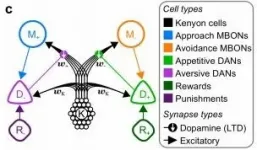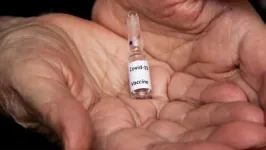(Press-News.org) Anesthestic drugs act on the brain but most anesthesiologists rely on heart rate, respiratory rate, and movement to infer whether surgery patients remain unconscious to the desired degree. In a new study, a research team based at MIT and Massachusetts General Hospital shows that a straightforward artificial intelligence approach, attuned to the kind of anesthetic being used, can yield algorithms that assess unconsciousness in patients based on brain activity with high accuracy and reliability.
"One of the things that is foremost in the minds of anesthesiologists is 'Do I have somebody who is lying in front of me who may be conscious and I don't realize it?' Being able to reliably maintain unconsciousness in a patient during surgery is fundamental to what we do," said senior author Emery N. Brown, Edward Hood Taplin Professor in The Picower Institute for Learning and Memory and the Institute for Medical Engineering and Science at MIT, and an anesthesiologist at MGH. "This is an important step forward."
More than providing a good readout of unconsciousness, Brown added, the new algorithms offer the potential to allow anesthesiologists to maintain it at the desired level while using less drug than they might administer when depending on less direct, accurate and reliable indicators. That can improve patient's post-operative outcomes, such as delirium.
"We may always have to be a little bit 'overboard'," said Brown, who is also a professor at Harvard Medical School. "But can we do it with sufficient accuracy so that we are not dosing people more than is needed?"
Used to drive an infusion pump, for instance, algorithms could help anesthesiologists precisely throttle drug delivery to optimize a patient's state and the doses they are receiving.
Artificial intelligence, real-world testing
To develop the technology to do so, postdocs John Abel and Marcus Badgeley led the study, published in PLOS ONE [LINK TBD], in which they trained machine learning algorithms on a remarkable data set the lab gathered back in 2013. In that study, 10 healthy volunteers in their 20s underwent anesthesia with the commonly used drug propofol. As the dose was methodically raised using computer controlled delivery, the volunteers were asked to respond to a simple request until they couldn't anymore. Then when they were brought back to consciousness as the dose was later lessened, they became able to respond again. All the while, neural rhythms reflecting their brain activity were recorded with electroencephalogram (EEG) electrodes, providing a direct, real-time link between measured brain activity and exhibited unconsciousness.
In the new work, Abel, Badgeley and the team trained versions of their AI algorithms, based on different underlying statistical methods, on more than 33,000 two-second-long snippets of EEG recordings from seven of the volunteers. This way the algorithms could "learn" the difference between EEG readings predictive of consciousness and unconsciousness under propofol. Then the researchers tested the algorithms in three ways.
First, they checked whether their three most promising algorithms accurately predicted unconsciousness when applied to EEG activity recorded from the other three volunteers of the 2013 study. They did.
Then they used the algorithms to analyze EEG recorded from 27 real surgery patients who received propofol for general anesthesia. Even though the algorithms were now being applied to data gathered from a "noisier" real-world surgical setting where the rhythms were also being measured with different equipment, the algorithms still distinguished unconsciousness with higher accuracy than other studies have shown. The authors even highlight one case in which the algorithms were able to detect a patient's decreasing level of unconsciousness several minutes before the actual attending anesthesiologist did, meaning that if it had been in use during the surgery itself, it could have provided an accurate and helpful early warning.
As a third test, the team applied the algorithms to EEG recordings from 17 surgery patients who were anesthetized with sevoflurane. Though sevoflurane is different from propofol and is inhaled rather than infused, it works in a similar manner, by binding to the same GABA-A receptors on the same key types of brain cells. The team's algorithms again performed with high, though somewhat reduced accuracy, suggesting that their ability to classify unconsciousness carried over reliably to another anesthetic drug that works in a similar way.
The ability to predict unconsciousness across different drugs with the same mechanism of action is key, the authors said. One of the main flaws with current EEG-based systems for monitoring consciousness, they said, is that they don't distinguish among drug classes, even though different categories of anesthesia drugs work in very different ways, producing distinct EEG patterns. They also don't adequately account for known age differences in brain response to anesthesia. These limitations on their accuracy have also limited their clinical use.
In the new study, while the algorithms trained on 20-somethings applied well to cohorts of surgery patients whose average age skewed significantly older and varied more widely, the authors acknowledge that they want to train algorithms distinctly for use with children or seniors. They can also train new algorithms to apply specifically for other kinds of drugs with different mechanisms of action. All together a suite of well trained and attuned algorithms could provide high accuracy that accounts for patient age and the drug in use.
Abel said the team's approach of framing the problem as a matter of predicting consciousness via EEG for a specific class of drugs made the machine learning approach very simple to implement and extend.
"This is a proof of concept showing that now we can go and say let's look at an older population or let's look at a different kind of drug," he said. "Doing this is simple if you set it up the right way."
The resulting algorithms aren't even computationally demanding. The authors noted that for a given 2 seconds of EEG data, the algorithms could make an accurate prediction of consciousness in less than a tenth of a second running on just a standard MacBook Pro computer.
The lab is already building on the findings to refine the algorithms further, Brown said. He said he also wants to expand testing to hundreds more cases to further confirm their performance, and also to determine whether wider distinctions may begin to emerge among the different underlying statistical models the team employed.
INFORMATION:
In addition to Brown, Abel and Badgeley, the paper's other authors are Benyamin Meschede-Krasa, Gabriel Schamberg, Indie Garwood, Kimaya Lecamwasam, Sourish Chakravarty, David Zhou, Matthew Keating and Patrick Purdon.
Funding for the study came from the National Institutes of Health, The JPB Foundation, A Guggenheim Fellowship for Applied Mathematics, and Massachusetts General Hospital.
Even the humble fruit fly craves a dose of the happy hormone, according to a new study from the University of Sussex which shows how they may use dopamine to learn in a similar manner to humans.
Informatics experts at the University of Sussex have developed a new computational model that demonstrates a long sought after link between insect and mammalian learning, as detailed in a new paper published today in Nature Communications.
Incorporating anatomical and functional data from recent experiments, Dr James Bennett and colleagues modelled how the anatomy and physiology of the fruit fly's brain can support learning according to the reward prediction error (RPE) hypothesis.
The computational model indicates how dopamine neurons in an area of ...
PITTSBURGH, May 7, 2021 - In a paper published today in Nature Communications, an international group of collaborators led by researchers at UPMC Children's Hospital of Pittsburgh have identified a genetic cause of a rare neurological disorder marked by developmental delay and loss of coordination, or ataxia.
The disorder, scientists found, is caused by mutations in a protein called GEMIN5--one of the key building blocks of a protein complex that controls RNA metabolism in neurons. No mutations in GEMIN5 were previously linked to any genetic disease. ...
Luxembourg, 7 May 2021 - In a new position statement, Alzheimer Europe has issued a call for prioritisation of people with dementia and their carers in national COVID-19 vaccination strategies, urging governments to recognise the disproportionate effect of the pandemic on these groups.
Alzheimer Europe has today issued a call for people with dementia and their carers to be given priority in the ongoing COVID-19 vaccination campaigns across Europe.
In its position statement, Alzheimer Europe notes that people with dementia have almost twice the risk for developing COVID-19 compared to their ...
Systemic inequalities mean that low-income households in London are more likely to be exposed to higher levels of indoor air pollution, according to a report by UCL researchers.
The biggest factors are the quality of housing and the characteristics of the surrounding environment, taking location and levels of outdoor air pollution into account - factors beyond occupants' control.
Air pollution exposure is the greatest environmental health threat in the UK, with long-term exposures estimated to cause 28,000-36,000 premature deaths a year.
In the paper, published in Buildings and Cities, researchers used available data and models, assembling evidence to examine five factors explaining why lower socio-economic groups may be exposed to higher levels of indoor air pollution ...
LUGANO, 7 May, 2021- Findings presented at today's EADV 2021 Spring Symposium suggest that an imbalance in gut microbiota (dysbiosis), could play a significant role in the progression of inflammatory skin disease, Hidradenitis Suppurativa (HS). HS is a painful, long-term skin condition, with a chronic and relapsing nature that significantly impacts patients' quality of life.
Researchers at Hacettepe University collected faecal samples from 15 patients with HS and 15 age and sex matched healthy individuals and analysed regions of the bacterial 16S rRNA gene to investigate ...
LUGANO, 6 May, 2021- The dermatological impact of COVID-19 is a burning topic at EADV's 2021 Spring Symposium. New research presented today highlights the effect that stringent hand hygiene during the pandemic has had on hand skin health.1
Researchers at Father Muller Medical College, India, analysed transepidermal water loss (TEWL - an essential parameter for measuring skin barrier function) from 582 people (291 healthcare professionals (HCPs) and 291 healthy individuals from the general population). Results indicated that hand dermatitis was now present among 92.6% of HCPs and 68.7% of the general population, despite only ~3% of HCPs and 2.4% of the general public in the study having reported a prior history of hand dermatitis (obtained through medical history ...
Are penalty shots a soccer player's dream or nightmare? What should be an easy shot can become a mammoth task when the hopes and fears of an entire nation rest on a player's shoulders, leading them to choke under pressure. Understanding the brain activity behind choking is the driving force behind a new study in open-access journal Frontiers in Computer Science. The study is the first to measure brain activity during penalty shots in a soccer pitch environment. It finds that people who choked activated areas of the brain involved in long-term thinking, suggesting that they were overthinking the consequences of missing the shot. ...
Researchers from University of Southern California, Bocconi University, and Vrije Universitei Amsterdam published a new paper in the Journal of Marketing that explains the six types of judgements consumers make when determining a product's authenticity and how marketers can use this insight to deliver more authentic offerings.
The study, forthcoming in the Journal of Marketing, is titled "The Concept of Authenticity: What it Means to Consumers" and is authored by Joseph Nunes, Andrea Ordanini, and Gaia Giambastiani.
Consumers crave authenticity. Yet marketing itself is typically considered inherently inauthentic. Hence, firms must learn to understand, manage, and excel at rendering authenticity. The critical question is: how? Marketers who wish to deliver authentic consumption experiences ...
INDIANAPOLIS - As electronic medical records (EMRs) are increasingly used across the United States, the next generation of physicians, nurses, social workers, pharmacists and other clinicians need to acquire new knowledge and competencies related to use of EMRs early in their clinical education. But training is not routinely provided.
A new study presents the functions and application of the novel, scalable Regenstrief teaching electronic medical record (tEMR) platform which contains a unique, large, anonymized patient database enabling health professions students to learn how to use health information technology (HIT) to best manage the ...
The way that many of us live has created the "perfect storm" for the evolution and transmission of infectious diseases like Covid-19 according to a researcher at the University of East Anglia.
A new editorial published today describes how the world's vast population of people, pets and livestock has created an ideal breeding ground for infectious diseases which are passed between humans and animals.
It shows how we urgently need to control the transmission of pathogens such as SARS-CoV-2 by using vaccination passports, maximising genetic variation in livestock, and reducing how much meat we eat.
Prof Cock Van Oosterhout, from UEA's School of Environmental Sciences, said: "We humans have been living in a non-sustainable way over the past few centuries. We now have a vast population size ...




